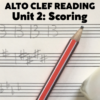(Tip no. 06 from 100 MORE Orchestration Tips, to be released in 2020.)
The resonance of violins tends to absorb the sound of a flute an octave higher. This effect can be used to enhance the timbre of the violins.
Once upon a time there was a young orchestrator who scored an exposed first flute line tracking the first violins at an octave above, with both parts marked mezzo-forte. Imagine that orchestrator’s surprise at rehearsal when the flute part seemed inaudible, though the first violins were undoubtedly richer in timbre and more incisive in articulation. Even more puzzling, neither the first flutist nor the conductor seemed to notice the problem. At the orchestrator’s request, the conductor instructed the flutist to play forte and the strings to sit back a little – and while that worked better according to the original intentions, it threw other carefully calculated values out of whack.
Our orchestrator should have done more score-reading and listening. The orchestra didn’t notice the problem because to them, there was no problem. This was simply a well-worn phenomena going back to the origins of concert music. A flute note an octave above a section of violins will tend to become enveloped into the overall resonance. It will still be audible to keen ears; but the more seamlessly the flute player matches the violins’ dynamics and articulation, the more that their function becomes an adjunct.
I’ve mentioned this before in videos released on the Orchestration Online YouTube channel, but only in passing. Let’s examine the phenomenon in detail, so you can use it both wisely – and intentionally. First, the mechanics: string instruments, very much like double-reeds and brass, tend to bring out the second partial harmonic an octave above the root note. This means that part of what a listener hears when a violin plays an E5 is also the resonance of an E6. The bigger the section, the smoother and more pronounced the effect. This is why string section octaves create so much excitement – each instrumental group locks in progressively higher into the lower group’s sweet spot, to imply a searching quality with so many unified tones.

The other half of this equation is the character of the flute’s tone. It resembles the implied resonance of the strings’ octave overtone. At an octave above the strings, all things being equal, the flute’s root tone can slip almost seamlessly into place with the string overtone, and to all intents and purposes disappear as an independent element of texture. We see this already at work in the craft of early orchestrators such as Mozart, notably in passages of his Symphony no. 40 in G minor. Where an oboe or clarinet would be easily heard an octave higher than the firsts, Mozart’s single flute tends to unite with little notice.

So if the flute isn’t going to be heard anyway, then why bother? The answer is that it gives the top voice of the strings a unique edge that wouldn’t be there otherwise. In the Mozart example above, this edge is like a pearly glow. But the effect can be more than gentle – at louder dynamics, single notes and even harmonised melodies can help make the violins slash through the sound picture like a razor. A great example is found in Ravel’s orchestration of the opening Promenade from Mussorgsky’s Pictures at an Exhibition. At bar 13, flutes and piccolo track the first and second violins an octave higher, lending the strings a shining, even chiming quality – while not really calling much attention to themselves if played correctly. Interestingly, the firsts are being doubled by first oboe, first clarinet, and partially by first trumpet; while the seconds are being doubled by second and third oboe and second trumpet. This provides more than enough cover into which the flutes can seem to evaporate while supporting the overtones.

It’s intriguing how easily this trick falls apart the second that the flutes pull away from a rigid position of doubling at an octave higher than the first violins. All it takes is a high pedal tone, contrary motion, or even a parallel harmony in 3rds or 6ths, and the flutes’ independence is immediately reaffirmed. As the flutes should be: it’s a shame to waste their valuable resource of technique and timbre simply making the violins sound better or thicker all the time.










